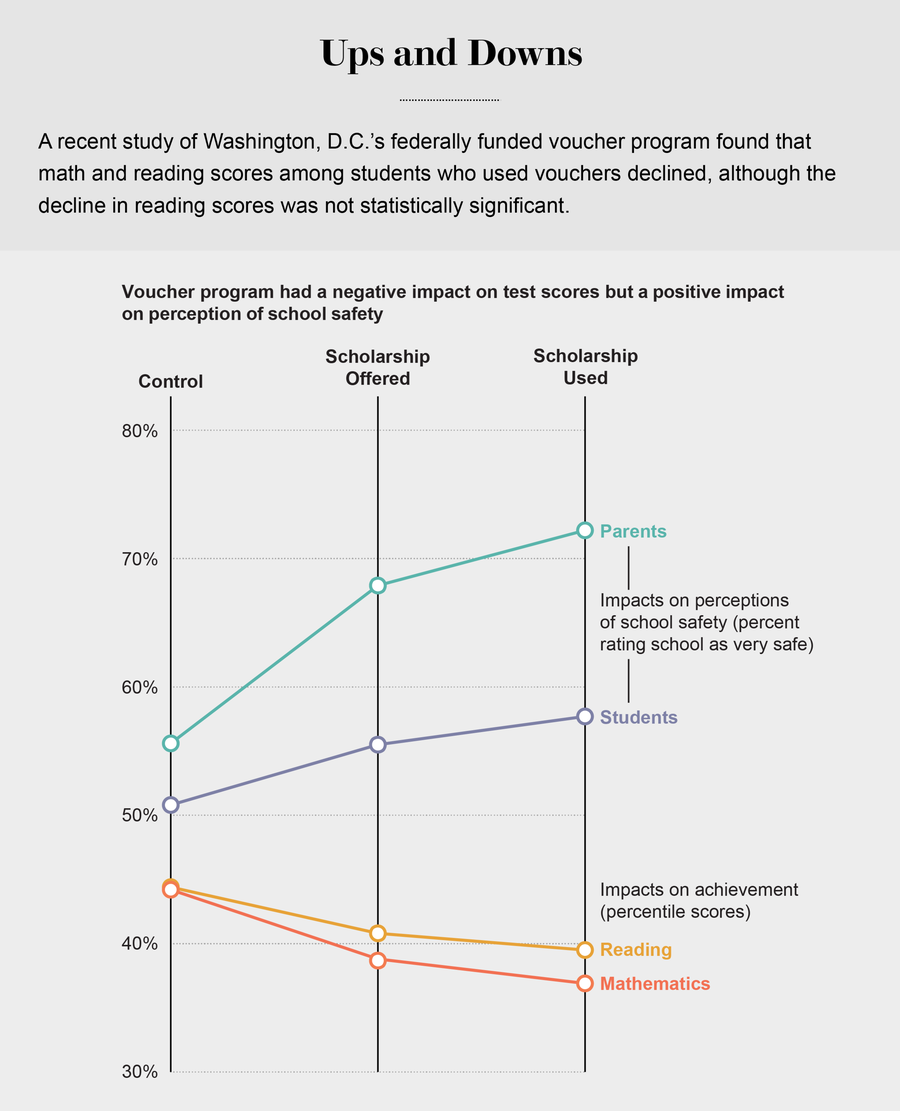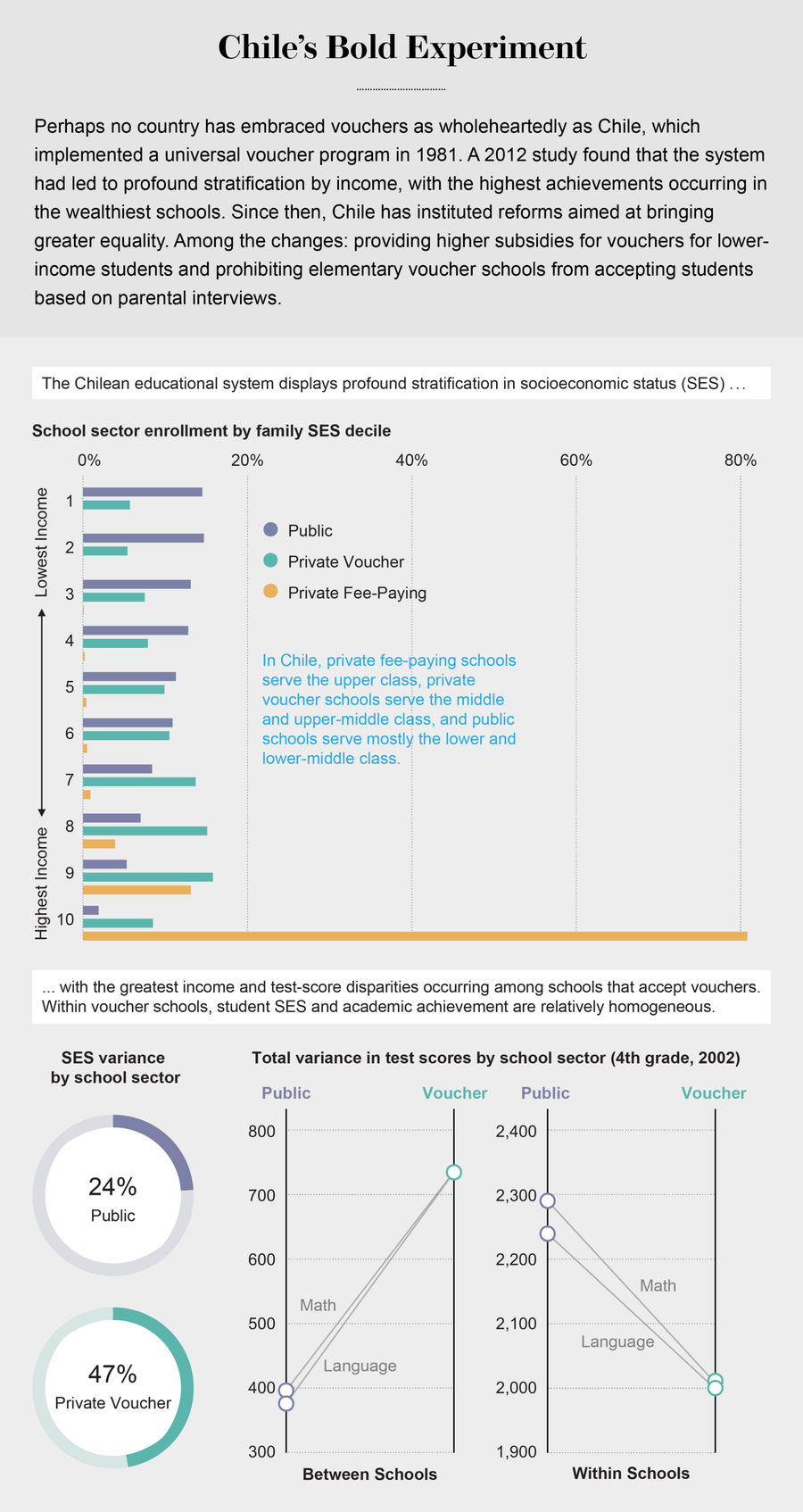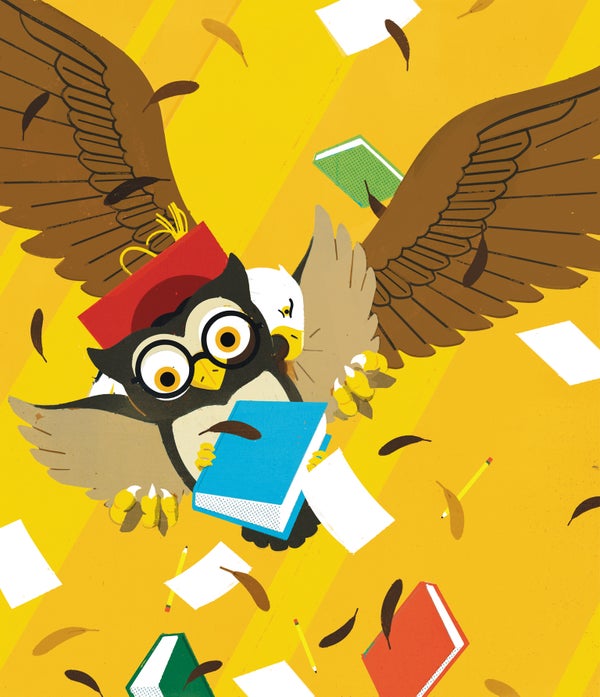In a 1955 essay, free market visionary Milton Friedman proposed a revolutionary model of education. Rather than seeing public schools as a rich local resource and driver of social mobility, he suggested they were a reflection of government overreach. Because a stable and democratic society depends on an educated electorate, he reasoned, the government should pay for children to go to school. But that did not mean the government should run schools. Instead, Friedman said, it ought to require a minimum level of education. And to finance that education, it should give parents “vouchers redeemable for a specified maximum sum per child per year if spent on ‘approved’ educational services.” Breaking the government monopoly on education, he argued, would allow “consumers” (parents) to support the best “product”—that is, to enroll their kids in the most effective and highest-performing institutions. Mediocre public schools, subjected to market forces, would improve or perish.
The idea captured the imagination of elected officials and policy makers all over the world. Now President Donald Trump's secretary of education, Betsy DeVos, is preparing to give the scheme its first national rollout in the U.S. She has made voucher programs the centerpiece of her efforts to enhance educational outcomes for students, saying they offer parents freedom to select institutions outside their designated school zone. “The secretary believes that when we put the focus on students, and not buildings or artificially constructed boundaries, we will be on the right path to ensuring every child has access to the education that fits their unique needs,” says U.S. Department of Education spokesperson Elizabeth Hill.
Because the Trump administration has championed vouchers as an innovative way to improve education in the U.S., Scientific American examined the scientific research on voucher programs to find out what the evidence says about Friedman's idea. To be sure, educational outcomes are a devilishly difficult thing to measure with rigor. But by and large, studies have found that vouchers have mixed to negative academic outcomes and, when adopted widely, can exacerbate income inequity. On the positive side, there is some evidence that students who use vouchers are more likely to graduate high school and to perceive their schools as safe.
On supporting science journalism
If you're enjoying this article, consider supporting our award-winning journalism by subscribing. By purchasing a subscription you are helping to ensure the future of impactful stories about the discoveries and ideas shaping our world today.
DeVos's proposal marks a profound change of direction for American education policy. In 2002, under President George W. Bush's No Child Left Behind Act, the federal education mantra was “what gets tested, gets taught,” and the nation's public schools became focused on shaping their curriculum around state standards in reading and math. Schools where students struggled to perform at grade level in those subjects were publicly dubbed “failing schools.” Some were sanctioned. Others were closed. During those years, networks of privately operated, publicly funded charter schools, many of them with a curriculum that was rigorously shaped around state standards, opened, and about 20 percent of them flourished, giving parents in some low-income communities options about where to enroll their child. While charter schools got much of the media attention, small voucher programs were being piloted in Washington, D.C., and bigger programs were launched in Indiana, Wisconsin, Louisiana and Ohio.
Most school voucher programs were, at least originally, launched to help some of the most disadvantaged students. They target kids in poor urban communities with a high concentration of African-American and Latino children who would otherwise attend local public schools that have failed to show appropriate academic progress. The design of voucher programs varies from city to city and state to state, but in general, families are eligible to enroll in the voucher program if their local public school is troubled and if their child has been accepted into a private or parochial program. Those families then enroll in the voucher programs and are given a “scholarship”—usually in the $4,000 to $5,000 range—to defray (but typically not entirely cover) the cost of private tuition. In some programs, money comes from funds allocated for public education in the state coffers. Other programs depend on tax credits that allow individuals and corporations to make donations to a voucher fund or families to deduct some of the cost of private or parochial tuition and pay fewer annual state taxes.
A Mixed Picture
Until now, only a handful of American cities and states have experimented with voucher programs. Around 500,000 of the country's 56 million schoolchildren use voucher-type programs to attend private or parochial schools. The results have been spotty. In the 1990s studies of small voucher programs in New York City, Washington, D.C., and Dayton, Ohio, found no demonstrable academic improvement among children using vouchers and high rates of churn—many students who used vouchers dropped out or transferred schools, making evaluation impossible. One study of 2,642 students in New York City who attended Catholic schools in the 1990s under a voucher plan saw an uptick in African-American students who graduated and enrolled in college but no such increases among Hispanic students.
In 2004 researchers began studying students in a larger, more sustained voucher plan that had just been launched in Washington, D.C. This is the country's first and so far only federally sponsored voucher program. There 2,300 students were offered scholarships, and 1,700 students used those scholarships mostly to attend area Catholic schools. The analysts compared academic data on those who did and did not opt for parochial school and found that voucher users showed no significant reading or math gains over those who remained in public school. But graduation rates for voucher students were higher—82 percent compared with 70 percent for the control group, as reported by parents. A new one-year study of the Washington, D.C., program published in April showed that voucher students actually did worse in math and reading than students who applied for vouchers through a citywide lottery but did not receive them. Math scores among students who used vouchers were around 7 percentage points lower than among students who did not use vouchers. Reading scores for voucher students were 4.9 percentage points lower. The study authors hypothesized that the negative outcomes may be partly related to the fact that public schools offer more hours of instruction in reading and math than private schools, many of which cover a wider diversity of subjects such as art and foreign languages.
Evaluations of some of the largest voucher programs—in Indiana (34,000 students) and in Louisiana (8,000 students)—also show negative outcomes. A four-year study of a sample of the 28,000-student voucher program in Milwaukee, which has a troubled public school system, found that for three years, between 2006 and 2009, there was no significant difference in academic gains between students who used vouchers to attend private schools and those who remained in traditional public schools. In the 2010–2011 school year, the voucher students made larger gains in reading and math—that same year the state legislature demanded that voucher kids be given state tests and that the scores be made public. Experts suggest that the threat of publicly revealing test scores caused private schools to create curriculums that conformed to state standards.
In a 2016 study of Ohio's Educational Choice (EdChoice) Scholarship program, which has used public money to supplement the tuition of 18,000 students at private and parochial schools, researchers used longitudinal data from 2003 through 2013 to examine academic outcomes of students who used vouchers and those who were eligible but did not transfer to a private school. (Because the Ohio voucher program requires children who use taxpayer money to take state tests, apples-to-apples scores were readily available.) They found that when children transferred out of their public schools through the program, their math scores—and to a lesser extent, their reading scores—dropped significantly and stayed depressed. “I was surprised by the negative—it's a big negative,” says study co-author David Figlio of Northwestern University. He speculates that the negative outcome might have occurred because top private schools opted out of the voucher program because they did not wish to make students take state tests. As a result, voucher students were left with mostly subpar options. “A lot of the reason that parents are interested in sending kids to private schools is that there is too much testing in public,” he says.

Credit: Tiffany Farrant-Gonzalez; Source: Evaluation of the DC Opportunity Scholarship Program: Impacts after One Year. Mark Dynarski et. al. U.S. Department of Education, April 2017
Better-performing students were the ones who used the voucher program, the study found. Interestingly, students who were left in Ohio public schools actually did better on standardized tests once the voucher program got under way, suggesting that public schools might have responded to the increased “competition” by teaching a curriculum aligned to the standards to be tested—or by doubling down on test preparation.
Ty Vinson, a mother of three from Columbus, Ohio, enrolled her children in a local Christian school using the EdChoice program. But after their test scores dropped, she switched them out. Vinson says she worried that her third, sixth and eighth graders, who earned straight A's at their new school, were not challenged enough.
Still, she appreciated the experience. “They got to be involved in activities like science fairs and poetry contests. They do offer art, music, science and all the different areas of the curriculum, some of which are not offered so much in the public schools,” she notes. But she decided to move her children back to the online charter school they were attending before. Vinson has not considered public school, she says, because her family is black, and she perceives too many racial issues in the local schools.
Voucher system in chile
Other countries, namely Sweden, the Netherlands, New Zealand and Colombia, have experimented with voucher programs, also with mixed results. But no country embraced the scheme as wholeheartedly as Chile, which implemented a universal voucher program in the 1980s under dictator Augusto Pinochet. Before the reform, three types of schools existed in Chile: public (accounting for 80 percent of the enrollment), subsidized private (14 percent)—largely Catholic schools—and fee-paying private for the elite (6 percent). In 1981 the system was decentralized, and parents could enroll their children in public municipal schools, subsidized private schools that accepted vouchers, and nonsubsidized private schools, which charged about five times the amount of the government subsidy and were thus available only to the elite. Middle-class families stampeded out of public schools. By 2002 private voucher schools reached 38 percent of enrollments, at the expense of the public sector, which dropped to 53 percent. By 2004 private voucher enrollment had reached 41 percent. Poor families, many of whom were unable to gain admission to private schools or lived in rural areas without private schools, stayed in the public system. By 2006, 42 percent of students in the lowest income quintile of the population, 28 percent of students from the second-lowest quintile and 4 percent from the wealthiest quintile attended public schools.
In the early 2000s Alejandra Mizala, an economist at the University of Chile, and Florencia Torche, a sociologist now at Stanford University, launched a comprehensive study of fourth and eighth grade students in public and private voucher schools in Chile using census data and information about parental education and income. In a paper published in 2012 in the International Journal of Educational Development, the researchers found that enrollment in private voucher schools created a hierarchy, with private school students segregating themselves by income. “A much larger proportion of the variance in socioeconomic status is between schools in the private-voucher sector than in the public one,” the study authors wrote. “This pattern suggests that while the private-voucher sector serves an economically diverse population, each voucher school focuses on a socioeconomically homogeneous community.”
In other words, economic stratification in Chile increased under vouchers by the type of school and by actual school community. Although there are no good studies that track socioeconomic stratification through vouchers in the U.S., research conducted by Halley Potter, a senior fellow at the progressive Century Foundation, has shown that voucher programs tend to exacerbate racial segregation in both public and private schools. Further, she found that more highly educated parents, often a proxy for families with a higher income, are more likely to use vouchers to transfer their children to private schools.
Safety vs. achievement
In the face of such mixed results, what is motoring voucher programs forward? A few studies, including an early look at the federally funded Washington, D.C., program, have shown that vouchers can boost high school graduation and college matriculation rates. Advocates say those measures are more important than achievement on state tests. “We should care about education attainment: how long they stay in the system and degrees they obtain. That is more predictive of life outcomes,” says Patrick Wolf, co-author of The School Choice Journey and education professor at the University of Arkansas. But such sentiments are at odds with how we have long demanded our public schools operate. For two decades policy makers have harshly criticized public schools for social promotion—the practice of moving a child to the next grade level regardless of academic achievement. The merit of public schools was determined solely on the number of students achieving mastery of state standards, as indicated by standardized scores.

Credit: Tiffany Farrant-Gonzalez; Source: “Bringing the Schools Back In: The Stratification of Educational Achievement in the Chilean Voucher System,” by Alejandra Mizala and Florencia Torche, in International Journal of Educational Development, Vol. 32, No. 1; January 2012
Reading and math scores may also not be the most important consideration for parents. The April study of Washington, D.C.'s voucher program found that parents of children who used vouchers were more likely to rate their child's school as very safe, for example. Some religiously affiliated parents may also perceive more value in a school's culture than in standardized test results. “If I'm a deeply religious person, I might choose an education where my children are raised according to my religious values and culture,” says Robert Pondiscio, a senior fellow at Thomas B. Fordham Institute, a right-leaning think tank in Washington, D.C. “I have a view of my child's education that is more than test scores. Other factors may weigh more heavily.”
But other experts worry that vouchers too often shuffle students from one failing system of schools to another. Northwestern's Figlio suggests creating a team of inspectors to conduct top-to-bottom reviews of schools that take vouchers. “There are truly terrible schools in terms of literacy and numeracy,” he says. “We can't just let the market run and assume people will be in good schools. There should be some allowance for accountability.” That takes us back to the question of who should decide which schools are “good” and how.
Voucher proponents say parents, even those using tax dollars to pay tuition, should be able to use whatever criteria for school choice they see fit. A provocative idea, but if past evidence can predict future outcomes, expanding voucher programs seems unlikely to help U.S. schoolchildren keep pace with a technologically advancing world.
What Makes a Good School?
It is a question experts have debated at least since Socrates developed his famous instructional method. In the past several years researchers have homed in on factors that predict high academic achievement in K–12 schools. Unfortunately, in the U.S., those components still cluster in institutions that serve students from high socioeconomic backgrounds—an imbalance that Secretary of Education Betsy DeVos says vouchers can address. Here are some of the constants that good schools share, according to studies.
A carefully sequenced curriculum that provides broad content knowledge in English, math, science, history, art and music. For many years researchers did not understand the power of content knowledge to improve skills such as reading comprehension and critical thinking. Lately neuroscientists—and some high-performing district and charter schools—have begun focusing on the importance of building factual knowledge in children, especially those from low-income families. Yet it is important that content be taught in an engaging way and not through rote memorization.
Math introduced in the earliest grades and taught by a content expert. If a content expert is not available, then the teacher should at least take real joy in math instruction. Math phobia is highly contagious and difficult to cure.
Daily physical activity. As the focus on testing grew more intense, PE dropped out of school schedules. But science suggests that all kids should get 60 minutes of moderate aerobic exercise every day to be at their cognitive best.
Safety. In 1908 Arthur C. Perry, principal of a Brooklyn high school, published The Management of a City School, describing how school climate affects learning. Since then, researchers who study cognition have mostly agreed with his theories—more learning takes place in classrooms with fewer disruptions.
Experienced teachers. Recent studies suggest that teachers continue to gain mastery in instruction (as measured by student test scores) and student engagement (as measured by absenteeism) throughout their first 10 years in the classroom. —P.T.

